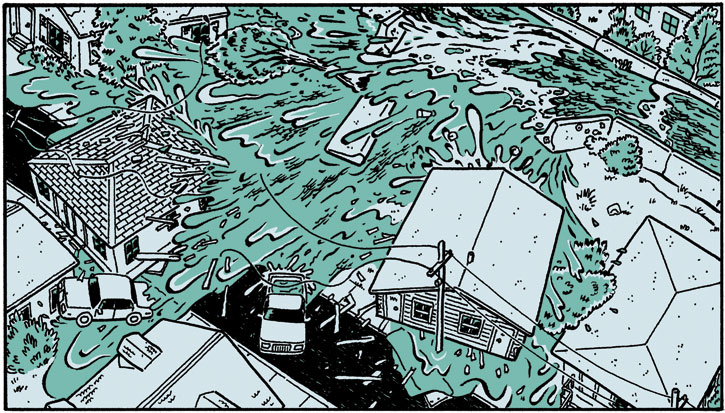
The Book of Basketball
By Bill Simmons
ESPN, 2009
Like Gilbert Arenas' gunhandling and sharpshooting ways, ESPN writer Bill Simmons’ new Book of Basketball is a polarizing force. Sports types love him and hate him, all the while turning that interest into fat checks that other sportswriters can only imagine as heaven.
There's no stretch to suggest that Bill Simmons is perhaps the most successful Internet writer ever, his words appearing on screen long before they ever inhabited a place in a magazine. He started on some AOL sports site, gained a loyal following for essentially being one of the few relevant sports columnists to young males, daring to talk about Swingers and Vince Vaughn alongside the Boston Red Sox while others could only discuss moral turpitude and the modern athlete.
Everything Simmons did seems like no big deal now, but I guess it was and somehow he has become the most successful sportswriter in America, even though he stays at his house most of the time, never sits in a press box and has season tickets to the historically worst professional sports team.
It would be annoying for Simmons to beat his uniqueness over our heads, and he doesn’t do that in this book, but his manner seems quite irreverent for a hardcover book and basketball. All his sexual jokes are unusual in this form, where on the Internet it doesn’t seem bad at all, maybe just tame. But to talk frankly about strippers in relationship to Jason Kidd is not really funny, just kind of odd, as I can’t believe this guy is married sometimes, his frankness embarrasses me as if I'm a 7th grader reading Madame Bovary.
There exists a running count of Boogie Nights jokes, and the number dials high, and so a fictional movie about a porn star is his grand allusion, his literary cred running high. But no one came to Simmons for his literary cred, but precisely because he dared to make those comparisons in the first place. So though Boogie Nights is beat like a dead horse, that becomes the point--to beat a dead horse as many times as possible.
But concentrating on those things is not the point of the book, in fact this discussion at NY Mag, made me think the whole book was about sex. When in fact, it’s about basketball. But not an encyclopedia of basketball, or a chronology of basketball, but more of an interesting paradigm to discuss basketball. Much of the book’s structure derives from actual conversations, claims Simmons, in the vein of one of his favorite buddy-Vegas movies apparently. So there’s a pyramid of the greatest 90 some odd players to have played the game of basketball, a riveting chapter on the debate of Chamberlain vs. Russell and a ranking of the most dominant teams best in the spirit of Keyser Soze (watch The Usual Suspects).
It is no surprise that the Boston Celtics have a significant role in this book, much because Simmons is a Boston native, raised on the Celtics and Larry Bird and the legend of Bill Russell. But even though Simmons cares deeply about the Celtics, his arguments in favor of them are well-reasoned and factually based, the only subjective part is how high to rank Rober Parrish over James Worthy or the proper place of Dennis Johnson in the pantheon of minor all-stars. This pyramid ranking of the greats is the meatiest of the book, though his meeting with Isaiah Thomas to discuss “the secret” is the crux of Simmons’ argument, boiling down to the fact that basketball is not about basketball, meaning that the me-first Chamberlain fails to the team-first Russell, that Jordan understood “the secret” after two years off playing baseball, that Kobe may not have grasped “the secret” until Shaq/Jackson troubles and rape accusations.
I actually liked the ending interview with Bill Walton better, where Walton frames it as players making "a choice" to be unselfish, rather than "the secret." But Simmons met Isaiah Thomas at a topless bar and he only met Walton in his house, so "the secret" it is.
But I generally support Simmons’ outlook on basketball. I enjoy Magic Johnson. I understand the greatness of Hakeen Olajuwon and how underrated Tim Duncan is. I don’t think John Stockton or Patrick Ewing were as bad as Simmons says. Now he is rightfully Kevin Durant’s greatest cheerleader.
Back over at NY Mag, they try to dissect “micro” vs. “macro” Simmons, meaning can you put up with Simmons’ style to understand his points? Many times, I can’t. As a frequent reader of his columns, I bypass all of his football columns, because I don’t enjoy whining about fantasy teams and Simmons has singlehandedly made me want to avoid ever watching Swingers or the aforementioned Boogie Nights—I get enough of those two cinematic masterpieces from the scraps and fragments I pull together from all of Simmons’ columns and books. His boyhood fantasies and trips to Vegas have proven proper canon fodder for quite awhile, he’s going to have to take a few more local trips through Hollywood or twist his writing into sassy parenting metaphors a la Neal Pollack to stick around much longer. In other words, even Vince Vaughan has grown up.
This edition of the Book of Basketball may be Simmons’ last stand with his most familiar metaphors. With the rise of Deadspin and more focus on differing approaches to basketball in general (read FreeDarko.com), Simmons is dangerously close to becoming the new old guard. But this book is a powerful defense. More after the jump...






